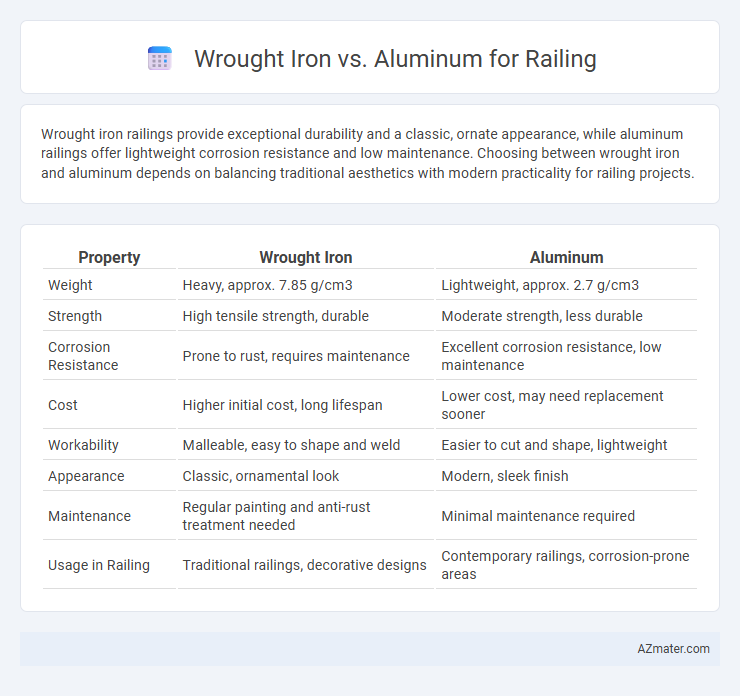Wrought iron railings provide exceptional durability and a classic, ornate appearance, while aluminum railings offer lightweight corrosion resistance and low maintenance. Choosing between wrought iron and aluminum depends on balancing traditional aesthetics with modern practicality for railing projects.
Table of Comparison
| Property | Wrought Iron | Aluminum |
|---|---|---|
| Weight | Heavy, approx. 7.85 g/cm3 | Lightweight, approx. 2.7 g/cm3 |
| Strength | High tensile strength, durable | Moderate strength, less durable |
| Corrosion Resistance | Prone to rust, requires maintenance | Excellent corrosion resistance, low maintenance |
| Cost | Higher initial cost, long lifespan | Lower cost, may need replacement sooner |
| Workability | Malleable, easy to shape and weld | Easier to cut and shape, lightweight |
| Appearance | Classic, ornamental look | Modern, sleek finish |
| Maintenance | Regular painting and anti-rust treatment needed | Minimal maintenance required |
| Usage in Railing | Traditional railings, decorative designs | Contemporary railings, corrosion-prone areas |
Introduction to Railing Materials
Wrought iron offers exceptional strength and intricate design possibilities, making it a durable and decorative choice for railings. Aluminum provides lightweight corrosion resistance and low maintenance, ideal for coastal or humid environments. Both materials present unique benefits for railing applications, with wrought iron emphasizing traditional robustness and aluminum focusing on modern practicality.
Wrought Iron Railing Overview
Wrought iron railings are renowned for their exceptional strength, durability, and classic aesthetic appeal, making them a preferred choice for both residential and commercial applications. Unlike aluminum, wrought iron offers superior resistance to bending and impact, ensuring long-term structural integrity and security. Its ability to be intricately crafted into ornamental designs enhances architectural value, while requiring minimal maintenance compared to aluminum railings.
Aluminum Railing Overview
Aluminum railings offer lightweight durability and resistance to rust, making them ideal for outdoor use compared to traditional wrought iron. They require minimal maintenance and provide a modern aesthetic with various customizable designs and finishes. Aluminum's corrosion resistance and ease of installation contribute to its growing popularity in residential and commercial railing applications.
Durability Comparison
Wrought iron railings offer exceptional durability due to their high tensile strength and resistance to impact, making them ideal for heavy-duty applications. Aluminum railings provide excellent corrosion resistance and require less maintenance but are generally less robust under extreme physical stress. When comparing longevity, wrought iron typically outlasts aluminum in harsh environments, although aluminum's rust resistance gives it an advantage in coastal or humid areas.
Aesthetic Differences
Wrought iron railings exhibit a classic, ornate aesthetic with intricate designs and a dark, matte finish that adds a timeless, elegant appeal to architectural spaces. Aluminum railings offer a sleek, modern appearance with smooth surfaces and a variety of powder-coated color options, providing a contemporary, minimalist look. The choice between wrought iron and aluminum significantly influences the visual style, with wrought iron favoring traditional charm and aluminum supporting modern design trends.
Maintenance Requirements
Wrought iron railings require regular maintenance, including rust prevention treatments and periodic painting to protect against corrosion, especially in humid or coastal environments. Aluminum railings offer low-maintenance benefits as they resist rust and typically need only occasional cleaning to maintain their appearance. Choosing aluminum reduces long-term maintenance costs and labor compared to the upkeep needed for wrought iron railings.
Cost Analysis
Wrought iron railings typically cost between $25 and $50 per linear foot, offering durability and a classic aesthetic but requiring higher initial investment and maintenance expenses due to susceptibility to rust. Aluminum railings range from $20 to $40 per linear foot, providing a lightweight, corrosion-resistant option with lower installation and upkeep costs. Comparing lifecycle costs, aluminum offers better long-term value for budget-conscious projects, while wrought iron commands premium pricing for strength and traditional appeal.
Installation Process
Wrought iron railings require professional welding and precise fitting due to their heavy weight and rigid structure, often leading to longer installation times compared to aluminum. Aluminum railings feature lightweight components that are easier to handle and typically utilize bolt-together or snap-in assemblies, allowing for faster, more straightforward installation. Choosing aluminum can reduce labor costs and installation complexity while wrought iron provides unmatched durability and aesthetic appeal.
Weather Resistance
Wrought iron railings are highly durable but prone to rust and corrosion when exposed to harsh weather conditions unless regularly maintained with paint or protective coatings. Aluminum railings offer excellent weather resistance due to their natural oxidation layer, which prevents rust and requires minimal upkeep. This makes aluminum a superior choice for outdoor railings in environments with high humidity, salt exposure, or frequent rain.
Best Applications for Each Material
Wrought iron railings are best suited for decorative and architectural applications requiring high strength, durability, and intricate designs, making them ideal for historic homes, ornate staircases, and security gates. Aluminum railings excel in environments needing lightweight, corrosion-resistant, and low-maintenance solutions, perfect for outdoor decks, balconies, and coastal properties. Each material offers distinct advantages: wrought iron provides superior rigidity and classic aesthetics, while aluminum delivers versatility and weather resistance.

Infographic: Wrought iron vs Aluminum for Railing
 azmater.com
azmater.com